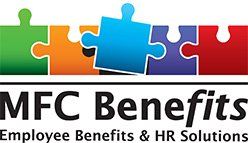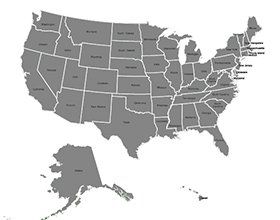Blog Post
Live Well, Work Well - December 2023
Zywave, Inc • Dec 14, 2023
Health and Wellness tips brought to you by MFC Benefits, LLC

Learn more about how to manage financial stress during the holidays, mindful holiday eating and when the best time to work out is.
MANAGING FINANCIAL STRESS DURING THE HOLIDAYS
If the holiday shopping season stresses you out, you’re not alone. Research by financial services company Bankrate revealed that more than half (54%) of holiday shoppers expect to feel financially burdened this holiday season as they anticipate overall high costs.
American consumers will spend an average of $1,530 this season for gifts, travel, and entertainment, a 7% increase from 2022, according to PwC.
While American consumers no longer face inflation levels like last year’s holiday season, they are still concerned about costs. Bankrate estimates that 87% of holiday shoppers plan to use at least one money-saving strategy, such as:
• Buying fewer items
• Seeking out more coupons or sales
• Starting holiday shopping earlier
• Purchasing cheaper brands
• Making gifts or crafts
• Obtaining more used or secondhand items
Financial anxiety and stress can be debilitating. Consider these Bankrate tips for managing holiday induced financial stress and anxiety:
• Discuss low-cost ways to celebrate with family and friends.
• Get comfortable with saying no to additional spending.
• Establish a realistic holiday spending budget.
• Make shopping lists.
• Download apps for rewards, discounts and cashback.
• Practice mindfulness when you’re feeling stressed.
• Find joy and practice self-care.
If you’re feeling significant stress, consider talking to a mental health professional for guidance and support.
MINDFUL HOLIDAY EATING
The holiday season often means more parties and gatherings—and an abundance of festive food and drinks. However, practicing mindful holiday eating can help you savor the season without overdoing it. This healthy approach encourages focusing on preparing and consuming food in a distraction-free environment. Thinking about the food may make you more aware of your hunger and fullness cues. Mindful eating offers physical and mental health advantages, such as:
• Better body cue recognition
• Overeating prevention
• Healthier food choices
• Stress reduction
• Weight loss
Mindful eating doesn’t mean avoiding eating your favorite holiday foods. It’s simply about bringing more awareness and enjoyment to your food. Also, focus on the social aspect of gatherings and engaging in meaningful conversations. By practicing mindful holiday eating, you can enjoy the season and create lasting memories. Contact a dietitian if you need guidance with mindful eating.
WHEN'S THE BEST TIME TO WORK OUT?
A new study published in the journal Obesity explored the best time of the day to exercise to gain health benefits. Findings suggest working out between 7-9 a.m. is best for weight management. Morning exercisers had a lower body mass index and waist circumference than those exercising later in the day.
Although this new research highlighted the best time of day to work out, it’s important to note that exercising at any time of the day is beneficial. Health experts say better sleep, mental health, brain health and physiological health are also important benefits of exercise. In the end, consistency is key with exercise. The type of exercise or when it’s being done isn’t as important as consistently getting in 150 minutes of moderate-intensity physical activity and two days of strength training activities. As always, talk to your doctor before starting a new exercise regimen.
This article is intended for informational purposes only and is not intended to be exhaustive, nor should any discussion or opinions be construed as professional advice. Readers should contact a health professional for appropriate advice. © 2023 Zywave, Inc. All rights reserved.
MANAGING FINANCIAL STRESS DURING THE HOLIDAYS
If the holiday shopping season stresses you out, you’re not alone. Research by financial services company Bankrate revealed that more than half (54%) of holiday shoppers expect to feel financially burdened this holiday season as they anticipate overall high costs.
American consumers will spend an average of $1,530 this season for gifts, travel, and entertainment, a 7% increase from 2022, according to PwC.
While American consumers no longer face inflation levels like last year’s holiday season, they are still concerned about costs. Bankrate estimates that 87% of holiday shoppers plan to use at least one money-saving strategy, such as:
• Buying fewer items
• Seeking out more coupons or sales
• Starting holiday shopping earlier
• Purchasing cheaper brands
• Making gifts or crafts
• Obtaining more used or secondhand items
Financial anxiety and stress can be debilitating. Consider these Bankrate tips for managing holiday induced financial stress and anxiety:
• Discuss low-cost ways to celebrate with family and friends.
• Get comfortable with saying no to additional spending.
• Establish a realistic holiday spending budget.
• Make shopping lists.
• Download apps for rewards, discounts and cashback.
• Practice mindfulness when you’re feeling stressed.
• Find joy and practice self-care.
If you’re feeling significant stress, consider talking to a mental health professional for guidance and support.
MINDFUL HOLIDAY EATING
The holiday season often means more parties and gatherings—and an abundance of festive food and drinks. However, practicing mindful holiday eating can help you savor the season without overdoing it. This healthy approach encourages focusing on preparing and consuming food in a distraction-free environment. Thinking about the food may make you more aware of your hunger and fullness cues. Mindful eating offers physical and mental health advantages, such as:
• Better body cue recognition
• Overeating prevention
• Healthier food choices
• Stress reduction
• Weight loss
Mindful eating doesn’t mean avoiding eating your favorite holiday foods. It’s simply about bringing more awareness and enjoyment to your food. Also, focus on the social aspect of gatherings and engaging in meaningful conversations. By practicing mindful holiday eating, you can enjoy the season and create lasting memories. Contact a dietitian if you need guidance with mindful eating.
WHEN'S THE BEST TIME TO WORK OUT?
A new study published in the journal Obesity explored the best time of the day to exercise to gain health benefits. Findings suggest working out between 7-9 a.m. is best for weight management. Morning exercisers had a lower body mass index and waist circumference than those exercising later in the day.
Although this new research highlighted the best time of day to work out, it’s important to note that exercising at any time of the day is beneficial. Health experts say better sleep, mental health, brain health and physiological health are also important benefits of exercise. In the end, consistency is key with exercise. The type of exercise or when it’s being done isn’t as important as consistently getting in 150 minutes of moderate-intensity physical activity and two days of strength training activities. As always, talk to your doctor before starting a new exercise regimen.
Download the PDF copy here.
Share
Tweet
Share
Mail

17 Oct, 2024
Learn more about the ACA's Pay-or-Play Affordability Percentage Increases for 2025 and the Mental Health Parity Law. ACA'S PAY-OR-PLAY AFFORDABILITY PERCENTAGE INCREASES FOR 2025 On Sept. 6, 2024, the IRS released the affordability percentage threshold for 2025 plan years under the Affordable Care Act's (ACA) pay-or-play rules. These rules require ALEs to offer affordable, minimum-value health coverage to their full-time employees (and dependents) or risk paying a penalty. For plan years beginning in 2025, employer-sponsored coverage will be considered affordable under the ACA's pay-or-play rules if the employee's required contribution for self-only coverage does not exceed 9.02% of their household income for the year. This is an increase from the affordability percentage for 2024 plan years (8.39%). Due to this increase, applicable large employers (ALEs) may have more flexibility when setting employee contribution levels for the 2025 plan year. The ACA's affordability test applies only to the portion of the annual premiums for self-only coverage and does not include any additional cost for family coverage. Also, if an employer offers multiple health coverage options, the affordability test applies to the lowest-cost option that provides minimum value. Because an employer generally will not know an employee's household income, the IRS has provided three optional safe harbors that ALEs may use to determine affordability based on information that is available to them: the Form W-2 safe harbor, the rate of pay safe harbor and the federal poverty level safe harbor. FINAL RULE STRENGTHENS MENTAL HEALTH PARITY LAW On Sept. 9, 2024, the Departments of Labor, Health and Human Services, and the Treasury (Departments) released a final rule to strengthen the requirements of the Mental Health Parity and Addiction Equity Act (MHPAEA). The final rule is designed to ensure that individuals do not face greater restrictions to obtaining mental health and substance use disorder (MH/SUD) benefits than they would face for medical/surgical benefits. The final rule adds protections against more restrictive nonquantitative treatment limitations (NQTLs), such as preauthorization requirements and network composition standards. For example, the final rule requires group health plans and health insurance issuers to collect and evaluate data related to the NQTLs they place on MH/SUD care and make changes if the data shows they are providing insufficient access. The final rule also establishes minimum standards for developing comparative analyses to assess whether NQTLs comply with MHPAEA's requirements. In most cases, employers rely on issuers and third-party vendors to prepare comparative analyses for their health plans. However, the final rule requires the comparative analyses for health plans covered by ERISA to include a fiduciary's certification that they have engaged in a prudent process and monitored their service providers. The final rule generally applies for plan years beginning on or after Jan. 1, 2025; however, certain key requirements, such as NQTL data requirements, apply for plan years beginning on or after Jan.1, 2026. Provided to you by MFC Benefits, LLC © 2024 Zywave, Inc. All rights reserved Download the PDF copy here. Link: http://chrome-extension://efaidnbmnnnibpcajpcglclefindmkaj/https://content.zywave.com/file/b6f7a224-b3a3-4409-a8f2-953f0994d66a/Benefits%20Buzz%20Newsletter%20January%202024.docx Link: http://chrome-extension://efaidnbmnnnibpcajpcglclefindmkaj/https://content.zywave.com/file/b6f7a224-b3a3-4409-a8f2-953f0994d66a/Benefits%20Buzz%20Newsletter%20January%202024.docx
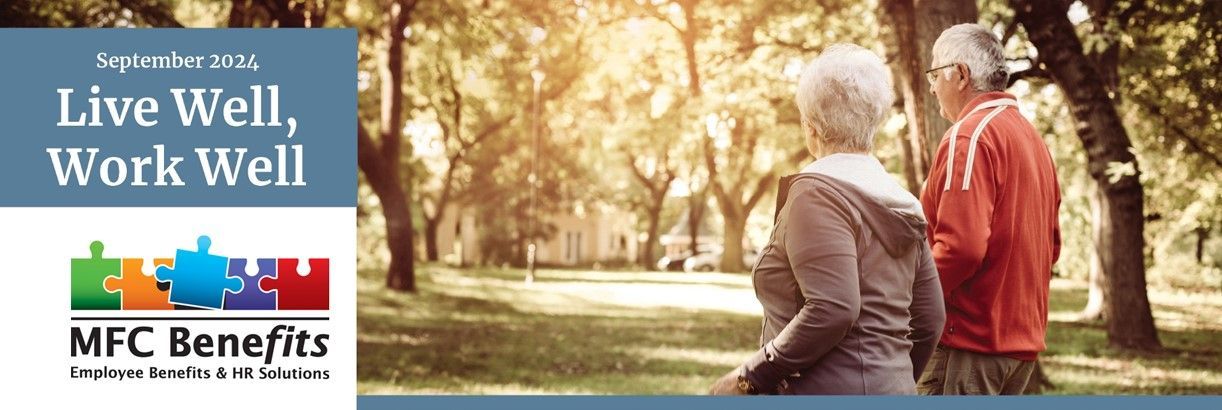
01 Oct, 2024
Learn more about cholesterol, knowing if you are prepared for a natural disaster, and the mental health crisis hotline. CHOLESTEROL AND YOU Cholesterol is a waxy substance found in your blood that your body needs to build cells; however, too much can pose a problem. Cholesterol travels through the blood on proteins called lipoproteins. There are two types of lipoproteins: 1. Low-density lipoprotein (LDL), known as bad cholesterol , makes up most of your body's cholesterol. High levels of LDL cholesterol can increase your risk for heart disease and stroke. 2. High-density lipoprotein (HDL), known as good cholesterol , absorbs cholesterol and carries it back to the liver to be flushed from the body. More than 40% of U.S. adults with high cholesterol don't know they have it, according to a study published in JAMA Cardiology. High cholesterol usually has no symptoms, so the American Heart Association (AHA) recommends that adults age 20 or older have their cholesterol checked every four to six years. Bad cholesterol can be elevated by age, family history, certain health conditions (e.g., Type 2 diabetes and obesity) and lifestyle factors. While you can't control all those risk factors, you can take steps to lower your risk for high cholesterol with the following lifestyle changes: - Eat a heart-healthy, balanced diet. Saturated and trans fats can increase your cholesterol, so focus on monounsaturated fats (e.g., olive oil, nuts, and avocados) and polyunsaturated fats (e.g., salmon, herring and margarine). Also, limit red meat, fried foods, processed meats and baked goods. - Exercise regularly. The AHA recommends individuals get at least 150 minutes of moderate aerobic exercise each week. Adding resistance exercises to your routine at least twice a week can further help. - Avoid or quit smoking. Smoking tobacco increases LDL cholesterol, decreases HDL cholesterol and can result in cholesterol buildup in one's arteries. - Limit alcohol use. If you consume alcohol, do so in moderation. For men, typically means up to 2 drinks per day, and for women, 1 drink per day. - Maintain a weight that is healthy for you. Having excess weight or obesity can increase your risk of developing high cholesterol levels. A doctor can help determine a sustainable weight management plan. The only way to know whether you have high cholesterol is to check your levels. Visit your doctor for a cholesterol screening and to discuss lifestyle risks. ARE YOU PREPPED FOR A DISASTER? Disasters such as hurricanes, tornadoes, floods and earthquakes can strike with little to no warning. September is National Preparedness Month, making it a good time for you and your household to make a plan if you need to evacuate your home or get trapped inside for days. The Federal Emergency Management Agency (FEMA) recommends discussing the following questions when creating an emergency plan: - How will I receive emergency alerts and warnings? - What is my shelter plan? - What is my evacuation route? - What is my household communication plan? - Do I need to update my emergency preparedness kit? You'll also need to consider your household's specific needs, make an emergency plan and practice it with your family members. These tips pertain to your home, but remember that emergencies can happen anywhere. Visit FEMA's website, Ready.gov, to learn more about preparing for emergencies at home, at work and on the road. Emergency Supply Kit Checklist - Water - Nonperishable food - Flashlight - Whistle - Dust mask - Local maps - Manual can opener - Battery-powered radio - First-aid kit - Pet supplies DON'T FORGET ABOUT THE 988 MENTAL HEALTH CRISIS HOTLINE The 988 Suicide and Crisis Lifeline (988) was launched nationwide in July 2022. Like dialing 911 for medical emergencies, people in emotional distress or suicidal crisis can call and text 988 to connect with counselors who will listen, provide support and connect them to resources. Since 988's launch, counselors have answered over 10 million calls, texts, and chats. Despite the volume, a new poll revealed that only 23% of Americans are at least somewhat familiar with 988. 988 provides immediate and accessible care to anyone experiencing mental health-related distress, including thoughts of suicide, mental health or substance use crisis, or other emotional struggles. It's vital to continue spreading the word about 988. People can also call if they are worried about a loved one who may need immediate support. This article is intended for informational purposes only and is not intended to be exhaustive, nor should any discussion or opinions be construed as professional advice. Readers should contact a health professional for appropriate advice. © 2024 Zywave, Inc. All rights reserved. Download the PDF copy here.

16 Sep, 2024
Learn more about the DOL Updates and the deadline to receive MLR rebates. DOL UPDATES MODEL EMPLOYER CHIP NOTICE The U.S. Department of Labor (DOL) has released a new model employer Children's Health Insurance Program (CHIP) notice with information that is current as of July 31,2024. The Children's Health Insurance Program Reauthorization Act of 2009 (CHIPRA) imposes an annual notice requirement on employers who maintain group health plans in states that provide premium assistance subsidies under a Medicaid plan or a CHIP plan. An employer can choose to provide the notice on their own or concurrent with the furnishing of: - Materials notifying the employee of health plan eligibility - Open enrollment materials - The summary plan description An employer is subject to this annual notice requirement if their group health plan covers participants who reside in a state that provides a premium assistance subsidy, regardless of the employer's location. The DOL's model notice, which employers may use for this disclosure, is updated periodically to reflect changes in the states that offer premium assistance subsidies. The DOL's model employer CHIP notice includes information that is current as of July 31, 2024. Employers could also choose to prepare their own notices or modify the model notice. Employers should be sure to include at least the minimum relevant state contact information for any employee residing in a state with premium assistance. DEADLINE FOR EMPLOYERS TO RECEIVE MLR REBATES IS APPROACHING Employers with insured group health plans may soon receive a medical loss ration (MLR) rebate from their health insurance issuers. Issuers who did not meet the applicable MLR percentage for 2023 must provide rebates to plan sponsors by Sept 30, 2024 . These rebates may be in the form of a premium credit or a lump-sum payment. The MLR rules require issuers to disclose how much they spend on health care and how much they spend on administrative costs, such as salaries and marketing. If an issuer spends less than 80% (85% in the large group market) of premium dollars on medical care and efforts to improve the quality of care, they must refund the portion of the premium that exceeds this limit. Issuers who issue rebates must provide plan sponsors and participants with a notice explaining the rebate and how it was calculated. Employers who receive MLR rebates should consider their options for using the rebate. Any rebate amount that qualifies as a plan asset under ERISA must be used for the exclusive benefit of the plan's participants and beneficiaries. In general, employers should use the rebate within three months of receiving it to avoid ERISA's trust requirement. In addition, employers who receive MLR rebates should be prepared to answer questions from employees about the rebate and how it is being allocated. Provided to you by MFC Benefits, LLC © 2024 Zywave, Inc. All rights reserved Download the PDF copy here. Link: http://chrome-extension://efaidnbmnnnibpcajpcglclefindmkaj/https://content.zywave.com/file/b6f7a224-b3a3-4409-a8f2-953f0994d66a/Benefits%20Buzz%20Newsletter%20January%202024.docx Link: http://chrome-extension://efaidnbmnnnibpcajpcglclefindmkaj/https://content.zywave.com/file/b6f7a224-b3a3-4409-a8f2-953f0994d66a/Benefits%20Buzz%20Newsletter%20January%202024.docx

23 Aug, 2024
Learn more about the health benefits of camping, the increase of drowning rates and if you are up to date on your immunizations. THE HEALTH BENEFITS OF CAMPING Millions of Americans enjoy camping each year, especially as temperatures rise and days get longer in the summer. Moreover, interest among noncampers has been growing steadily for years. According to a 2024 report by camping platform Dyrt, more than 20 million Americans have gone camping for the first time since 2021, including 5.5 million first-time campers just in 2023. Dyrt revealed that nearly 2 out of 3 Americans say they are somewhat interested in camping in the next three years. Camping has seen a resurgence in popularity as more people seek ways to unplug from their daily routines and reconnect with nature. Beyond the scenic views and adventures, camping offers the following wellness benefits that can significantly enhance your physical and mental health: Increased physical activity - camping naturally encourages movement. Activities such as hiking, setting up camp or gathering firewood provide a full-body workout. Boosted immune system - fresh air improves respiratory function and boosts the immune system. Sunlight helps the body produce vitamin D, which is crucial for bone health and immune support. Better sleep - natural light regulates the body's circadian rhythm, which can help reset sleep patterns. This can lead to deeper, restorative sleep so you wake up feeling refreshed. Reduced stress - the calming effect of natural surroundings helps lower levels of the stress hormone cortisol. Enhanced mood - exposure to green spaces and natural light can improve mood and reduce symptoms of anxiety and depression. Being outdoors can also trigger the release of endorphins, the body's natural mood enhancers. Elevated mental clarity - camping provides an opportunity to disconnect from technology and daily distractions, allowing for mindfulness. Heightened creativity - immersing yourself in nature can stimulate creativity and encourage problem-solving. Whether you're a seasoned camping pro or an eager newcomer, its a good idea to review camping safety before heading outdoors. Also, always strive to leave things better than you found them so others can enjoy the beauty of nature as you have. DROWNING RATES ON THE RISE After two decades of decline, the Centers of Disease Control and Prevention (CDC) reports that accidental drowning rates are increasing in the United States. According to the latest data, more than 4,500 people died due to drowning each year from 2020-2022, which is 500 more individuals per year compared to 2019. Drowning has long been the leading cause of death for preschool-age children. However, it's important to note that roughly 15% of adults - 40 million people - don't know how to swim, and more than half of adults have never taken a swimming lesson. The new CDC study found that, in general, many Americans lack the skills they need to stay safe in the water. Regardless of age, it's important to learn basic swimming and water safety skills. Check out the infographic below for water safety tips to help prevent drowning. Water Safety Tips: learn how to swim, wear life jackets when boating and swimming, avoid alcohol during water activities, know how to perform CPR, and supervise children around water. ARE YOU UP TO DATE ON YOUR IMMUNIZATIONS? August is recognized as National Immunization Awareness Month to promote the importance of immunizations at all life stages. Vaccination protects against severe illnesses and complications of vaccine-preventable diseases, including measles, polio, hepatitis, meningococcal meningitis and COVID-19. Vaccinations are so vital that the CDC offers immunization schedules to help you understand if you or others are up to date on shots: Infants and children (birth to age 6) Preteens and teens (ages 7-18) Adults (ages 19 and older) Pregnant women (before, during and after pregnancy) Talk to your doctor for more information on vaccines or to learn more about which ones you may need. This article is intended for informational purposes only and is not intended to be exhaustive, nor should any discussion or opinions be construed as professional advice. Readers should contact a health professional for appropriate advice. © 2024 Zywave, Inc. All rights reserved. Download the PDF copy here.

15 Aug, 2024
Learn more about the 5th Circuit Requires Health Plans to Continue Providing Free Preventive Care and Draft Forms for 2024 ACA Reporting Released 5TH CIRCUIT REQUIRES HEALTH PLANS TO CONTINUE PROVIDING FREE PREVENTIVE CARE The 5th U.S. Circuit Court of Appeals recently ruled that a key component of the Affordable Care Act’s (ACA) preventive care mandate is unconstitutional. However, in a decision it referred to as a “mixed bag,” the 5th Circuit limited its ruling to the plaintiffs in the case, a small group of individuals and businesses from Texas. The ACA requires non-grandfathered health plans and issuers to cover a set of recommended preventive services without imposing cost-sharing requirements, such as deductibles, copayments or coinsurance, when the services are provided by in-network providers. Court Decisions In March 2023, the U.S. District Court for the Northern District of Texas struck down a key component of the ACA’s preventive care mandate as unconstitutional and issued a nationwide injunction against its enforcement. This decision involved a wide range of preventive care services, such as cancer screenings and medications for chronic diseases. The 5th Circuit put the District Court’s decision on hold pending its ruling, which means health plans and issuers have been required to fully comply with the ACA’s preventive care mandate without interruption. Impact of 5th Circuit Ruling Health plans and issuers must continue to cover the full range of recommended preventive care items and services without cost sharing. Only the plaintiffs in the case are exempt from a portion of the ACA’s preventive care mandate. However, the future of the ACA’s free preventive care mandate remains uncertain. Employers should continue to watch for developments on this issue, as it is likely that the 5th Circuit's decision will be appealed to the U.S. Supreme Court. DRAFT FORMS FOR 2024 ACA REPORTING RELEASED The IRS has released draft 2024 forms for reporting under Internal Revenue Code Sections 6055 and 6056. Draft instructions for these forms have not yet been released. • The 2024 draft Forms 1094-B and 1095-B are draft versions of the forms used by providers of minimum essential coverage, including self-insured plan sponsors that are not applicable large employers (ALEs), to report under Section 6055. • The 2024 draft Forms 1094-C and 1095-C are draft versions of forms ALEs use to report under Section 6056 and for combined Section 6055 and 6056 reporting by ALEs who sponsor self insured plans. No major substantive changes were made to the draft forms for 2024 reporting. However, certain changes may be made once these forms are finalized or when draft or final instructions are released. Reporting Deadlines Individual statements for 2024 are due 30 days from Jan. 31, 2025. Because the deadline falls on a weekend, the individual statements must be furnished by the next business day, which is March 3, 2025. An alternative method of furnishing Form 1095-B is available. Electronic IRS returns for 2024 must be filed by March 31, 2025. Provided to you by MFC Benefits, LLC © 2024 Zywave, Inc. All rights reserved Download the PDF copy here. Link: http://chrome-extension://efaidnbmnnnibpcajpcglclefindmkaj/https://content.zywave.com/file/b6f7a224-b3a3-4409-a8f2-953f0994d66a/Benefits%20Buzz%20Newsletter%20January%202024.docx Link: http://chrome-extension://efaidnbmnnnibpcajpcglclefindmkaj/https://content.zywave.com/file/b6f7a224-b3a3-4409-a8f2-953f0994d66a/Benefits%20Buzz%20Newsletter%20January%202024.docx
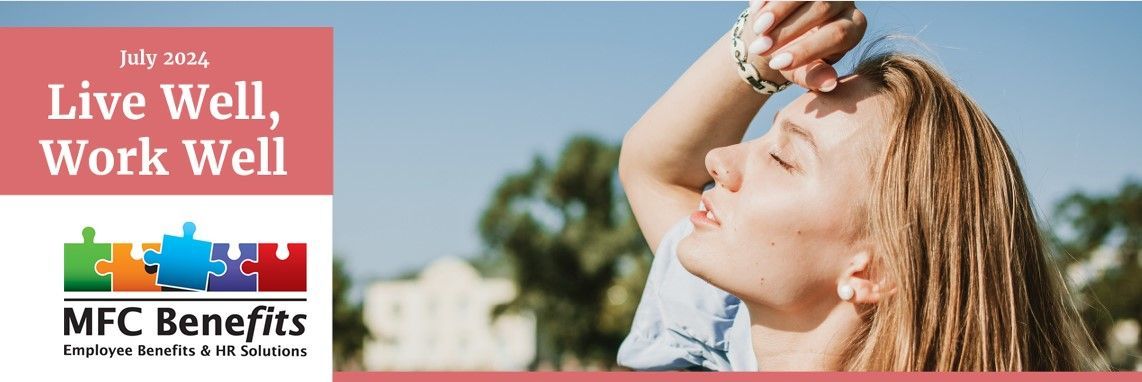
22 Jul, 2024
Learn more about how to beat the summer heat, grilling safety tips and how a healthy lifestyle may offset genetic risks by 62%. BEAT THE SUMMER HEAT Summer heat can be more than uncomfortable; it can threaten your health, especially for older adults and children. Hot and humid weather can make it more challenging for your body to cool down, leading to heat-related illnesses. If left untreated, heat-related illnesses can become life-threatening. In fact, heat-related deaths have been on the rise in the United States. The CDC reports that heat-related deaths in the country have been increasing, with approximately 1,602 occuring in 2021, 1,722 in 2022, and 2,302 in 2023. Exposure to abnormal or prolonged heat and humidity without relief or adequate fluids can cause various heat-related illnesses. Here are some common types of illnesses to keep an eye out for this summer: - Heat cramps are a mild form of heat illness consisting of painful muscle cramps and spasms. These occur during or after intense exercise and sweating in high heat, so moving to a cool place to rest and stretch cramped muscles is important. - Heat exhaustion occurs when a person cannot sweat enough to cool the body, usually due to not drinking enough fluids during hot weather. A person suffering from heat exhaustion must move to a cool place and drink plenty of water. - Heatstroke occurs when your body temperature reaches 104 F or higher within minutes. The person may also become confused or lose consciousness. The condition is the result of untreated heat exhaustion and a serious medical emergency that must be treated quickly by a professional. Don't let the summer heat get the best of you. Consider these tips to prevent heat-related illness: - Drink plenty of fluids, but avoid alcoholic and caffeinated beverages (e.g., coffee, tea and soda) that can lead to dehydration - Eat light, refreshing foods - Wear lightweight, light-colored and loose-fitting clothes - Apply sunscreen and wear a wide-brimmed hat and sunglasses - Do chores or other outdoor activities in the morning or evening - Stay indoors as much as possible, or take breaks from being outside Remembering these tips can help you beat the heat. Contact a doctor if heat-related symptoms don't improve within an hour and seek immediate medical attention if the person has heatstroke. GRILLING SAFETY TIPS Although grilling is a popular way to prepare food in the summer, it can also be dangerous. According to the National Fire Protection Association, an average of almost 11,500 home fires involve grills, hibachis or barbecues each year. May, June, July and August are the most active months for grill fires, with July being the top month. Keep the following safety suggestions in mind when grilling: - Keep your grill at least 10 feet away from other objects, including your house, decks and overhanging branches. - Set up the grill on a flat surface, and don't bring it into an unventilated or enclosed space (e.g., garage or porch) - Only use starter fluid with charcoal grills - never with gas grills - Keep children and pets at least 3 feet away from the area - Never leave your grill unattended - Clean the grates and trays to remove grease and fat buildup Overall, practicing vigilance and taking proper precautions can help reduce fire and associated burn injuries caused by grills. Safe Food Temperatures: Prevent foodborne illnesses grilling food to the USDA's proper internal temperatures. Poultry: 165 F, Ground Meats (including hot dogs and burgers): 160 F, Steaks, Roasts, and Chops: 145 F, and Fish: 145 F. HEALTHY LIFESTYLE MAY OFFSET GENETIC RISKS BY 62% Genetics may put some people at greater risk for a shorter lifespan or premature death; however, a healthy lifestyle could help significantly combat it. A new study found that risk could be mitigated by about 62% in people with a genetic disposition. Furthermore, those individuals could extend their lifespan by up to 5.5 years with a healthy lifestyle. The study identified four lifestyle factors that offered better benefits for counterbalancing genetics and prolonging the human lifespan: No current smoking, regular physical activity, adequate sleep duration and a healthy diet. Building a healthier lifestyle may sound challenging, but small changes can make a difference. Contact your doctor for additional guidance. This article is intended for informational purposes only and is not intended to be exhaustive, nor should any discussion or opinions be construed as professional advice. Readers should contact a health professional for appropriate advice. © 2024 Zywave, Inc. All rights reserved. Download the PDF copy here.

12 Jul, 2024
Learn more about the Group Health Plan Fiduciary Litigation on the Rise and PCORI Fees are due by July 31, 2024. GROUP HEALTH PLAN FIDUCIARY LITIGATION ON THE RISE The Employee Retirement Income Security Act of 1974 (ERISA) includes strict standards of conduct for fiduciaries, those who manage employee benefit plans and their assets. ERISA requires fiduciaries to discharge their duties regarding employee benefit plans: • Solely in the interest of plan participants and beneficiaries; • For the exclusive purpose of providing plan benefits or for defraying reasonable expenses of plan administration; and • With the care, skill, prudence and diligence that a prudent person in similar circumstances would use. The duty to act prudently is one of a fiduciary’s central responsibilities. Enforcement of ERISA’s strict standards of fiduciary conduct has traditionally been reserved for retirement plan sponsors. However, a new class action lawsuit highlights the importance of employers’ adherence to their fiduciary duties when managing their group health plans. The lawsuit against Johnson & Johnson alleges the company violated its ERISA fiduciary duties by mismanaging its prescription drug benefit, which cost the health plan and participants millions of dollars. It serves as a reminder to employers that they must prudently select and monitor plan service providers, such as pharmacy benefit managers (PBMs). Although it is the first case of its kind, more fiduciary litigation involving the management of prescription drug benefits is expected as the PBM industry faces increasing scrutiny and new transparency laws provide employees with more information regarding health care costs. PCORI FEES ARE DUE BY JULY 31, 2024 The Affordable Care Act requires employers with self-funded health plans and health insurance issuers to pay Patient-Centered Outcomes Research Institute fees (PCORI fees). The fees are reported and paid annually using IRS Form 720, the Quarterly Federal Excise Tax Return. Form 720 and full payment of the PCORI fees are due by July 31 of each year and generally covers plan years that end during the preceding calendar year. For plan years ending in 2023, the PCORI fees are due by July 31, 2024. In general, the PCORI fees are assessed, collected and enforced similarly to taxes. The PCORI fee amount is based on the average number of individuals covered under the plan. The IRS requires employers with self-funded health plans to use one of three alternative methods to determine the average number of individuals covered under the plan for a plan year: the actual count method, the snapshot method or the Form 5500 method. That number is then multiplied by the applicable rate for that tax year ($3 for plan years ending on or after Oct. 1, 2022, and before Oct. 1, 2023, or $3.22 for plan years ending on or after Oct. 1, 2023, and before Oct. 1, 2024). The IRS provides helpful resources regarding PCORI fees, including a chart on how the fees apply to specific types of health coverage or arrangements. Provided to you by MFC Benefits, LLC © 2024 Zywave, Inc. All rights reserved Download the PDF copy here. Link: http://chrome-extension://efaidnbmnnnibpcajpcglclefindmkaj/https://content.zywave.com/file/b6f7a224-b3a3-4409-a8f2-953f0994d66a/Benefits%20Buzz%20Newsletter%20January%202024.docx Link: http://chrome-extension://efaidnbmnnnibpcajpcglclefindmkaj/https://content.zywave.com/file/b6f7a224-b3a3-4409-a8f2-953f0994d66a/Benefits%20Buzz%20Newsletter%20January%202024.docx
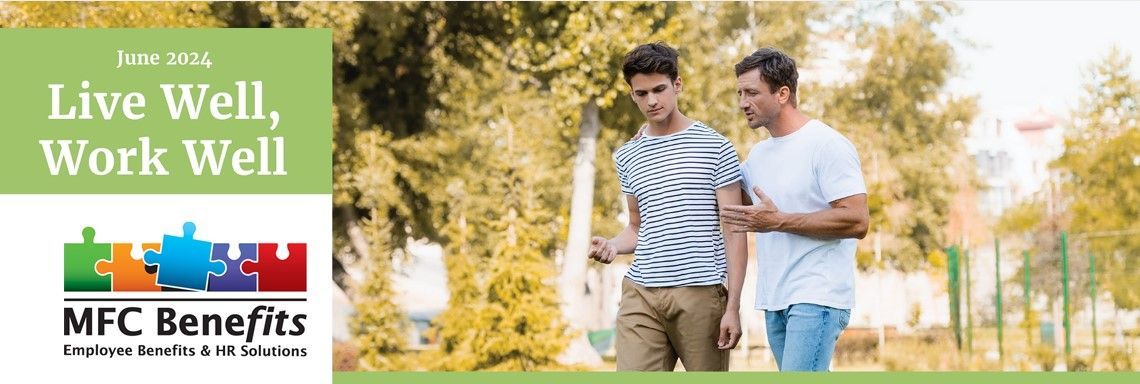
26 Jun, 2024
Learn more about exploring the great outdoors, the EWG's new Dirty Dozen list and a new study finds that women get more benefits from exercise than men. EXPLORE THE GREAT OUTDOORS Spending even a few moments outside daily can significantly improve your physical health by reducing muscle tension, regulating sleep and improving your work performance. Experiencing the outdoors - specifically, green spaces - can also provide some mental health benefits, including reduced anxiety and depression symptoms, decreased stress levels and improved overall mood. The Environmental Protection Agency reports t hat the average American spends only 7% of their life outdoors, with the rest spent inside. It may seem difficult to incorporate fresh air into your daily routine, so here are a few tips to spend more time in the great outdoors this summer: - Find time throughout the day to be outside. Try to walk or do a similar activity before or after your workday. Alternatively, enjoy lunch outside instead of eating at your desk during the workweek. If working remotely, you could join virtual meetings outside in a quiet place with little background noise or try "walking meetings" with teammates. Focus on finding small ways to incorporate fresh air into each day. - Move your workout outside. If you usually run on the treadmill, consider jogging around your neighborhood instead. Additionally, doing bodyweight or free weight exercises in your backyard or at a park can give you the same workout you would get in the gym but allow you to spend more time outside. - Focus on the quality - not quantity - of your time outdoors . While outside, try to really listen to and look at what's around you. Are there birds chirping? What color are the flowers? An intentional presence outdoors can help you feel more connected to nature and increase the benefits you receive from the fresh air. - Find someone to explore with. It can be much easier to start a new habit when you have someone to do it with. As such, consider getting together with a partner or a group of friends to participate in outdoor activities. - Bring nature indoors. Even when you can't get outside for very long, you can still bring little pieces of the outdoors into your home. Think about purchasing a few house plants to place around your home or starting an indoor herb garden. Spending time outdoors can improve your physical and mental health, so take advantage of the longer summer days and get outside. EWG RELEASES ITS DIRTY DOZEN LIST The Environmental Working Group (EWG) reports that 75% of all conventional fresh produce sampled this year had residue of potentially harmful pesticides. The "Dirty Dozen" items contain 95% of samples with pesticides. Each year, the EWG releases its Dirty Dozen report ranking pesticide residue levels based on samples taken by federal agencies. The EWG also compiles a "Clean Fifteen" list, with avocados and sweet corn leading the list. Whether organic or not, all properly handled fresh produce is considered safe to eat, so don't let the Dirty Dozen scare you away. Do your best to get your daily dose of healthy fruits and vegetables while still being an informed shopper. If you're still uneasy about pesticides after scrubbing your produce, frozen or canned versions can be a great alternative. Ultimately, it comes down to finding what works best for your household and budget. The 2024 Dirty Dozen: Strawberries, Spinach, Kale, Collard and Mustard Greens, Grapes, Peaches, Pears, Nectarines, Apples, Bell and Hot Peppers, Cherries, Blueberries, and Green Beans STUDY FINDS THAT WOMEN GER MORE BENEFITS FROM EXERCISE THAN MEN New study findings from the Centers for Disease Control and Prevention confirm that regular physical activity can prolong life and lower the risk of death. However, they also revealed that women experience greater benefits from exercise than men at lower amounts. Researchers found that while men were more likely to engage in physical activity than women, women who did so had a 24% lower risk of dying from any cause compared to inactive women. Physically active men had only a 15% lower risk than their inactive counterparts. Furthermore, the most beneficial amount of moderate-to-vigorous physical activity (e.g., brisk walking and cycling) was around five ours per week, though there were also benefits for women starting at just half that weekly amount. Women also saw a more significant reduction in mortality risk when incorporating muscle-strengthening activities (e.g., weightlifting) than men did. Always talk to your doctor before starting an exercise regimen. This article is intended for informational purposes only and is not intended to be exhaustive, nor should any discussion or opinions be construed as professional advice. Readers should contact a health professional for appropriate advice. © 2024 Zywave, Inc. All rights reserved. Download the PDF copy here.

18 Jun, 2024
Learn more about HSA/HDHP Limit Increase and HHS Finalizes HIPAA Privacy Changes for Reproductive Health Care. HSA/HDHP LIMITS WILL INCREAES FOR 2025 On May 9,2024, the IRS released Revenue Procedure 2024-2025 to provide the inflation-adjusted limits for health savings accounts (HSAs) and high deductible health plans (HDHPs) for 2025. The IRS is required to publish these limits by June 1 of each year. These limits include the following: The maximum HSA contribution limit; The minimum deductible amount for HDHPs; and The maximum out-of-pocket expense limits for HDHPs These limits vary based on whether an individual has self-only or family coverage under an HDHP. Eligible individuals with self-only HDHP coverage will be able to contribute $4,300 to their HSAs in 2025, up from $4,150 in 2024. Eligible individuals with family HDHP coverage will be able to contribute $8,550 to their HSAs in 2025, up from $8,300 in 2024. Individuals aged 55 or older may make an additional $1,000 "catch-up" contribution to their HSAs. The minimum deductible amount for HDHPs increases to $1,650 for self-only coverage and $3,300 for family coverage in 2025 (up from $1,600 for self-only coverage and $3,200 for family coverage in 2024). The HDHP maximum out-of-pocket expense limit increases to $8,300 for self-only coverage and $16,600 for family coverage in 2025 (up from $8,050 for self-only coverage and $16,100 for family coverage in 2024). HHS FINALIZES HIPAA PRIVACY CHANGES FOR REPRODUCTIVE HEALTH CARE The U.S. Department of Health and Human Services (HHS) issued a final rule that strengthens the HIPAA Privacy Rule by prohibiting the disclosure of protected health information (PHI) related to lawful reproductive health care in certain situations. According to HHS, these new protections are necessary to protect access to and privacy of reproductive health care following the U.S. Supreme Court's decision on Dobbs v. Jackson Women's Health Organization. The HIPAA Privacy Rule sets strict limits on the use, disclosure and protection of PHI by health care providers, health plans, health care clearinghouses and their business associates (regulated entities). Effective Dec. 23,2024 , the final rule prohibits regulated entities from using or disclosing PHI for the criminal, civil or administrative investigation of (or proceeding against) any person in connection with seeking, obtaining, providing or facilitating reproductive health care where such health care is lawful under the circumstances in which it is provided. To implement the prohibition, when a regulated entity receives a request for PHI potentially related to reproductive health care, the regulated entity generally must obtain a signed attestation that the use or disclosure is not for a prohibited purpose. In addition, the final rule requires entities to revise their notice of privacy practices to support reproductive health care privacy by Feb. 16, 2026 . Provided to you by MFC Benefits, LLC © 2024 Zywave, Inc. All rights reserved Download the PDF copy here. Link: http://chrome-extension://efaidnbmnnnibpcajpcglclefindmkaj/https://content.zywave.com/file/b6f7a224-b3a3-4409-a8f2-953f0994d66a/Benefits%20Buzz%20Newsletter%20January%202024.docx Link: http://chrome-extension://efaidnbmnnnibpcajpcglclefindmkaj/https://content.zywave.com/file/b6f7a224-b3a3-4409-a8f2-953f0994d66a/Benefits%20Buzz%20Newsletter%20January%202024.docx

22 May, 2024
Learn more about breaking down mental health stigma, the benefits of active recovery, and seasonal eating health benefits. BREAKING DOWN MENTAL HEALTH STIGMA May is Mental Health Awareness Month, a national health observance dedicated to shedding light on mental health conditions and fostering understanding and support for those experiencing them. Mental illnesses are among the most common health conditions in the United States. According to the National Alliance on Mental Illness (NAMI), 1 in 5 adults experience a mental health disorder each year. Despite the prevalence of illnesses and increasing recognition of mental health as a critical component of overall wellbeing, stigma remains a significant barrier to receiving treatment and support. The fear of judgement and discrimination often presents individuals from seeking help. NAMI reports that nearly 60% of adults with a mental illness didn't receive mental health services in the previous year. It's imperative to raise awareness and educate others about mental health to combat stigma and create a more compassionate and supportive society. Here are some tips for reducing the stigma associated with mental health: - Educate yourself and others . Understand the complexity of mental illness, including substance use disorders, can help dispel misconceptions. Take the time to learn about mental health conditions, symptoms and treatments. - Talk openly . Break the silence surrounding mental health by initiating open and honest conversations with friends, family and colleagues. By sharing personal experiences or listening without judgment, you can create a safe space for others. - Choose your words carefully . Avoid stigmatizing words and use person-first language emphasizing the individual, not their condition. - Encourage equality between physical and mental health conditions . Mental illness is a medical condition, so it should be treated just like a physical ailment. - Speak up . If you suspect someone is struggling with their mental health, send them messages of support or help them get on the path to treatment. By taking proactive steps to reduce mental health stigma, you can help create an inclusive and supportive environment where everyone feels empowered to seek help. Together, we can break down the barriers that stand in the way of healing and acceptance. THE BENEFITS OF ACTIVE RECOVERY A complete fitness routine includes training and strategic recovery. Unlike passive recovery, which involves rest, sitting or inactivity, active recovery keeps you moving and engaged in low-intensity exercises. Active exercises can facilitate faster muscle recovery and enhance performance. Think of it as an add-on to your fitness routine-recovering for 10 to 15 minutes after a strenuous workout or taking it easy the following day. Consider these benefits of active recovery activities: - reduced lactic acid buildup in muscles - decreased muscle soreness - improved circulation - flexibility maintenance - injury prevention Active recovery exercises are generally considered safe. However, avoiding active recovery is recommended if you're injured or in pain, and your doctor should immediatey evaluate you. TYPES OF ACTIVE RECOVERY yoga or stretching, light resistance training, self-myofascial release, walking or hiking, or cycling SEASONAL EATING HEALTH BENEFITS It’s normal to see the same produce available year-round in today’s market. However, that doesn’t mean the quality is the same throughout the seasons. Eating seasonally helps you take advantage of the harvest schedule. Fortunately, May is peak spring mode and offers a variety of produce. Spring vegetables include asparagus, artichokes, radishes, rhubarb and peas, as well as fruit like strawberries. Not only is spring produce vibrant and fresh tasting, but it also offers health benefits. Picked at the peak of their freshness and nutritional value, spring produce is packed with essential vitamins, minerals and antioxidants, providing a natural boost to your immune system and overall well-being. Eating seasonally also means you’re adding variety to your diet, along with diverse vitamins and minerals. Seasonality depends on where you live, so let nature be your guide at your local farmers market or grocery store. This article is intended for informational purposes only and is not intended to be exhaustive, nor should any discussion or opinions be construed as professional advice. Readers should contact a health professional for appropriate advice. © 2024 Zywave, Inc. All rights reserved. Download the PDF copy here.
Check Out Our Video
Book an Appointment
MFC Benefits, LLC
Fax: 248-714-6091
359 N. Main St.
Milford, Michigan 48381
Tel:
248-717-2970
Milford, Michigan 48381
Fax: 248-714-6091
Privacy Policy
| Do Not Share My Information
| Conditions of Use
| Notice and Take Down Policy
| Website Accessibility Policy
© 2024
The content on this website is owned by us and our licensors. Do not copy any content (including images) without our consent.
